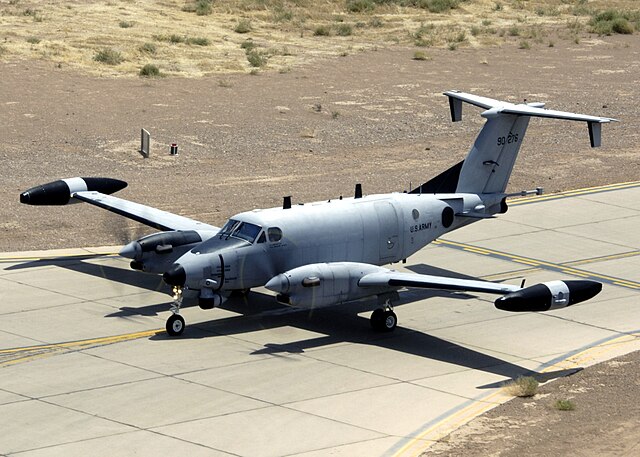Beechcraft RC-12 Guardrail
Signals intelligence aircraft From Wikipedia, the free encyclopedia
Signals intelligence aircraft From Wikipedia, the free encyclopedia
The Beechcraft RC-12 Guardrail is an airborne signals intelligence (SIGINT) collection platform based on the Beechcraft King Air and Super King Air. While the US military and specifically the United States Army have numerous personnel transport variants of the King Air platforms referred to with the general C-12 designation, the RC-12 specification refers to a heavily modified platform that collects SIGINT through various sensors and onboard processors.
| RC-12 Guardrail | |
|---|---|
 | |
| RC-12N | |
| Role | Signals intelligence aircraft |
| Manufacturer | Beechcraft |
| Introduction | 1983 |
| Status | Active service |
| Primary user | United States Army |
| Developed from | Beechcraft C-12 Huron |
The US Army Guardrail platform has been in service since 1971.[1] Prior to the early 1980s, the early Guardrail variants were based on the U-21. After adopting the C-12 platform over the U-21, the Guardrail platform has received structural, power plant, and equipment upgrades as noted by the various models described below.
Initially, the US Army had 13 RC-12Ds converted from C-12Ds, with deliveries starting in mid-1983. One aircraft was assigned to US Army Forces Command (FORSCOM) at Fort McPherson, Georgia, and the remainder to the 1st Military Intelligence Battalion at Wiesbaden, Germany, and the 2nd Military Intelligence Battalion at Stuttgart, Germany. The German-based aircraft were re-assigned in late 1991 to 3rd, 15th and 304th Military Intelligence Battalions at Camp Humphreys (South Korea), Fort Hood (Texas) and Fort Huachuca (Arizona) respectively. One was converted back to an earlier configuration as C-12D-1.[2]
The next model was the RC-12G. Three RC-12G were delivered in 1985 after conversion from C-12D airframes. These aircraft served in Latin America and then with the 138th Military Intelligence Company (Aerial Exploitation) in Orlando, Florida, before being moved into storage at Fort Sill, Oklahoma.[2]
After the RC-12G, the next model was the RC-12H. The initial system contractor ESL Inc. delivered 6 RC-12H in 1988 for the 3rd Military Intelligence Battalion at Camp Humphreys in Pyongtaek, South Korea.[2]

The next model was the RC-12K, after the RC-12H. The US Army ordered nine RC-12Ks in October 1985, of which eight replaced RC-12Ds in the 1st Military Intelligence Battalion in May 1991. One of these was lost in an accident. The ninth US Army aircraft was retained by the contractor, Raytheon, for conversion to the planned RC-12N configuration. An additional 2 RC-12K aircraft were delivered to Israel in May–June 1991.[2]
The prototype RC-12N was converted from an RC-12K. A total of 15 were converted by E-Systems and delivered 1992-93 to the 224th Military Intelligence Battalion at Hunter Army Airfield, Georgia and the 304th Military Intelligence Battalion at Libby Army Airfield, Fort Huachuca, Arizona. One of these was lost in accident.[2]
These led to the next model, the RC-12P. A total of 9 RC-12P aircraft were delivered to ESL/TRW at Moffett Federal Airfield in late 1994 and 1995. These airframes remained there in 1999.[2]
Three RC-12Ps were then modified by Raytheon and TRW to become RC-12Q. They were transferred to TRW in 1996 for outfitting, where they remained in 1999. The aircraft featured a prominent dorsal radome housing a satellite communications antenna.[2]
The RC-12 in various versions to include the newest RC-12X and RC-12X+ have seen deployments to Operation Enduring Freedom and Operation Iraqi Freedom. As of July 2012, Northrop Grumman announced that its RC-12X Guardrails had completed over 1,000 missions since going into theatre in 2011.[3] Recent upgrades and force realignments have seen these newest models replace older variants in Korea.
A 2017 $462 million RC-12X program, [4] by Northrop Grumman, will upgrade all aircraft in the Army's RC-12 fleet to the RC-12X standard, replacing or upgrading all older variants. The Guardrail Modernization program extends the life of the aircraft to 2025 and introduces new payloads to the system with enhanced capabilities. The program enhances the sustainability of the RC-12X through commonality, a new glass cockpit, structural upgrades, and significant hardware and software improvements.[5]
The newest Guardrail variant, the Guardrail Common Sensor (GR/CS), also called the RC-12X or RC-12X+, is a "fixed-wing, airborne, SIGINT-collection and precision targeting location system. It collects low-, mid- and high-band radio signals and ELINT signals, identifies and classifies them, determines source location, and provides near-real-time reporting. GR/CS uses a Guardrail Mission Operations Facility (MOF) for the control, data processing and message center for the system.”[6]

On 16 April 1997, the 224th Military Intelligence Battalion lost an RC-12N and 2 crew members in a fatal training accident. The following year on 6 November 1998, the 1st Military Intelligence Battalion lost a RC-12K and 2 crew members in a similar training accident.
In both accidents, the United States Army Safety Center Accident Boards listed in their recommendations to TRADOC to 'Re-evaluate the ATM Tasks for stalls, slow flight and VMC.' In February 1999, Commanding General, USAIC and FH, Major General John D. Thomas, sent a senior standardization instructor pilot and the 305th Military Intelligence Battalion Safety Officer to USAAVNC to review the RC-12K Accident Board findings to determine if training was a contributing factor. They recommended to Major General Thomas that the TC 1-219, Tasks for Slow Flight, Stalls and VMC, be rewritten.[2]

Data from operating manual [8]
General characteristics
Performance
Related development
Related lists
Seamless Wikipedia browsing. On steroids.
Every time you click a link to Wikipedia, Wiktionary or Wikiquote in your browser's search results, it will show the modern Wikiwand interface.
Wikiwand extension is a five stars, simple, with minimum permission required to keep your browsing private, safe and transparent.